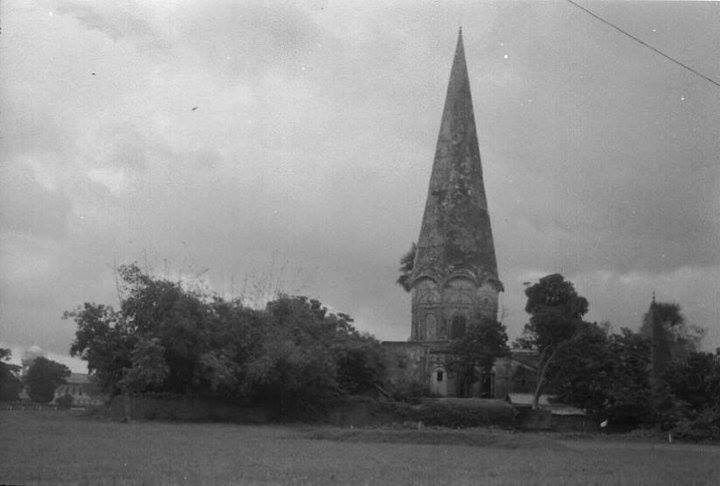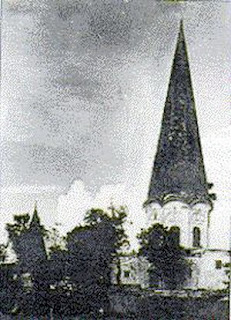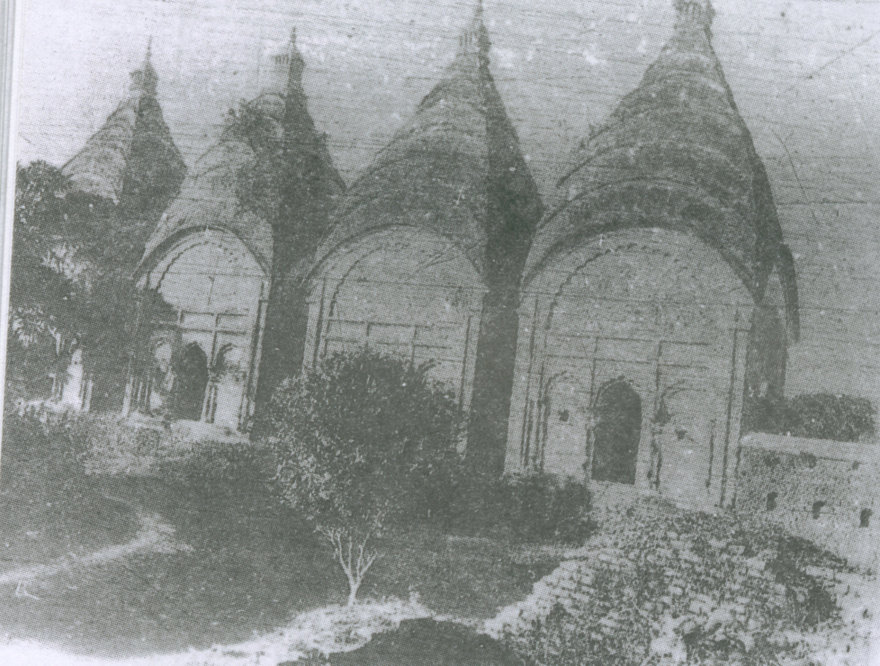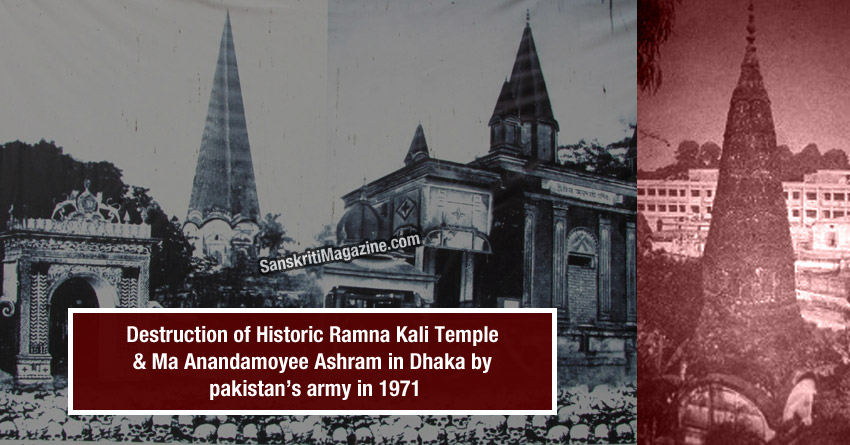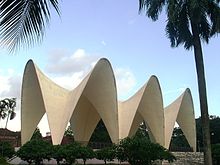A PRELIMINARY REPORT BY
THE COMMISSION FOR PUBLIC INQUIRY
The Pakistani Army in Bangladesh (Former East Pakistan) attacked and destroyed the historic Temple of the Hindu Goddess Kali located at Ramna on March 27, 1971. In the neighboring area, they attacked the famed Ma Anandmoyee Ashram, killing more than one hundred men, women and children. A Public Commission was constituted on March 27, 2000 to investigate the attack. The Chairman of the commission Justice K. M. Sobhan submitted a preliminary report on September 27, 2000 at the National Press Club in Dhaka. The report, as submitted, is given below:
At the early stages of the freedom struggle in 1971, the historic Ramna Kali Temple and the monastery of Ma Anandamoyee were turned into rubbles by the Pakistani occupation army and they killed well over a hundred people, including the Swamijis, worshippers, devotees, and the common people living in that area. No information or documentations about this incident were available to us. No newspaper or periodical ever published news about the many killing fields in the country and it has not been possible to rebuild the temples and the monasteries.
In order to investigate these incidents, a “Public Inquiry Commission for Destruction of Ramna Kali Temple and Ma Anandamoyee Ashram and Mass Murder” was formed on March 27, 2000. The Commission included six members and they are 1) Justice K. M. Sobhan, Chairman; 2) Prof. Muntashir Mamun, Member; 3) Writer Sahariar Kabir, Member; 4) Journalist Basudeb Dhar, Member-Secretary; 5) Dwipen Chatterjee, Member; and 6) Chandra Nath Poddar, Member.
The Commission was entrusted with the following tasks:
a) Prepare list of the victims of mass murder carried out in Ramna Kali Temple and Ma Anandamoyee Ashram on March 27, 1971.
b) Collect from the surviving eye witnesses, victims, and other sufferers, details of the torture, murder, and destruction perpetrated by the Pakistani invading forces.
c) Highlight the historical significance of the Temple and the Ashram.
d) Collect the opinion of the important public representatives with regard to the causes for destruction of the Temple and the Ashram and their rebuilding in future.
e) Review the efforts made to rebuild the Temple and the Ashram since 1972. Discuss other related matters.

Ramna Kali Temple: The 500 year old famed spiral temple was considered a symbol of Hinduism in Bangladesh
HISTORICAL PERSPECTIVES OF THE TEMPLE AND THE ASHRAM
Ramna Kali Temple and Ma Anandamoyee Ashram were built on 2.22 acre land in Dhaka. This land is situated on the southern side of the then Race Course Ground (Presently Surawardi Garden) and on the opposite side of Bangla Academy.
According to the historian Muntashir Mamun, the Kali Temple was built by “Darsanarthi” group of people who were followers of Sankaracharyay. Swami Gopal Giri of Badri Narayan Joshi Math came to Dhaka about 500 years ago and first founded a monastery at Ramna. At that time the monastery was known as ” Kaatghar “. Subsequently, the main Temple was built here by Haricharan Giri. This very Temple, built about 300 years ago, was destroyed on March 27, 1971 by the Pakistani invading army. Sreemath Swami Paramananda Giri was the temple priest when the Temple was destroyed. Although the Temple was built in the architectural style of Bengali Hindus, Islamic style was also noticed on the structure. 120 feet high peak extending over the second floor of the main Temple could be observed from far distant places. The peak of the Temple could be noticed as a landmark structure of Ramna in the well publicized photograph showing Bangabandhu Seikh Mujibur Rahaman lecturing at vast public gathering on Race Course Ground on March 7, 1971.
Beautiful image of Goddess Bhadrakali was seated on a wooden throne in the Temple and the Temple was surrounded by the wall of the Race Course Ground. To the right side of this image was the deity Kali of the Bhawals. The priests, worshipers, and other devotees lived in the rooms on north-easte and western sides of the Temple. There was also a Shiva Temple on the side. There was also the portico of the Temple and the main gate.
Islamic style was also noticed on the structure. 120 feet high peak extending over the second floor of the main Temple could be observed from far distant places. The peak of the Temple could be noticed as a landmark structure of Ramna in the well publicized photograph showing Bangabandhu Seikh Mujibur Rahaman lecturing at vast public gathering on Race Course Ground on March 7, 1971.
Beautiful image of Goddess Bhadrakali was seated on a wooden throne in the Temple and the Temple was surrounded by the wall of the Race Course Ground. To the right side of this image was the deity Kali of the Bhawals. The priests, worshipers, and other devotees lived in the rooms on north-easte and western sides of the Temple. There was also a Shiva Temple on the side. There was also the portico of the Temple and the main gate.
Ramna Kali Temple and Ma Anandamoyee Ashram were built on 2.22 acre land in Dhaka. This land is situated on the southern side of the then Race Course Ground (Presently Surawardi Garden) and on the opposite side of Bangla Academy.
According to the renowned historian of Pakistan, Dr. H. Dani, the lake in front of the temple building was excavated by Rani Bilashmani of Bhawal. However, difference in opinion is noticed in the documents of the British period. It is written in these documents that the English Magistrate Dos excavated the lake in front of the Kali Temple to remove the problem of water shortage for the people living in the neighboring areas. Considering the different views, it is believed that the lake was in existence over a long period of time and it was renovated by Rani Bilashmani of Bhawal. At present, this lake is the only reminder of the memories of Ramna Kali Temple and Ma Anandamoyee Ashram.
Ma Anandamoyee Ashram was situated on the northern side of Kali Temple. One saintly woman, known as ” the mother of Shahabagh ” was the wife of Ramani Mohan Chakrabarty who was the caretaker of Shahbagh Garden of the Nawab of Dhaka. Ramani Mohan came to Dhaka from Bajitpur for this job. Anandamoyee named her ascetic husband ‘Baba Bholanath’. During their stay in Shahabagh, both of them became well known, specially Ma Anandamoyee, for having strong spiritual power. Later on she was worshiped all over India as a saint. Their devotees built two monasteries, one each at Ramna and Sidheswari Temples, when they were living in Dhaka.
The Ashram at Ramna was built alongside the house of Ma Anandamoyee. Entrance was from the east side. The portico of the Temple was on the west side. In a small brick building on the north side was preserved the lotus feet of Ma Anandamoyee. The deities, Vishnu and Annapurna, were placed on the altar inside the temple. Underneath the altar, one could see the picture of goddess Kali. The deity, the picture of which could be seen, was kept in an underground room below the altar. Only once a year, during the birthday celebration of Ma Anandamoyee, this deity would be taken out for public viewing. At all other times, the deity was kept underground. Ma Anandamoyee lived in a thatched house with four roofs on the north-eastern side.
Beside the Swamijis, many common people used to live with families inside the compound of Ramna Kali Temple and Ma Anandamoyee Ashram. These people would take part in many celebrations and events held at the Temple and the Ashram. According to the statements given by the witnesses living at the temple, more than one hundred families lived there.

Ruins of the Ramna Kali Temple after the Pakistani army shelled the Temple in 1971.
The Commission for Public Hearing held sessions for 5 months, since April 13, 2000, in the Teachers’ Lounge, next to the cafeteria, in Teacher-Student Center of Dhaka University. The Commission took testimonies and comments from the family members of the martyrs perished in the diabolical carnage, other sufferers, political leaders, and the leaders of social, cultural, and professional organizations. Until now, the Commission recorded testimonies from more than one hundred people.
It was told by the witnesses that Pakistani invading army attacked the Bengalis on March 25th and entered into the Temple and Ashram compounds first at about 11 a.m. on March 26th. They ordered the residents not to venture outside the Temple and Ashram compounds. Around this time Khaja Khaeruddin, the Muslim League candidate defeated in election in the Seventies from old Dhaka area and also one of the proponents of Pakistan Military establishment at a later date, was found in the company of Pakistani forces. The destruction and massacre at Ramna took place in the dead of the night on March 27th on his instigation.
When evening curfew was in effect, Pakistani forces, along with their supporters, encirled the Ramna Kali Temple and Ma Anandamoyee Ashram at 2:00 a.m. in the night of March 27th. The whole Ramna area was well lit by the searchlights of Pakistani forces. Firing of the cannons started in the mean time. Upon entering the Ramna Kali Temple, the Pakistani forces started throwing some kind of explosives. However, some people said that they were firing cannons. As a result, the deity and the back portion of the Temple wall were completely blown away. Subsequently, the Temple and the Ashram were destroyed. Many people were sleeping and some were awake with anxiety when the executioners of Pakistani invading forces entered into the Temple and the Ashram. Members of some of the families were still taking dinner. They started running around in fear for their lives when the Pakistani army attacked. Every body started shouting the slogan “Pakistan Jindabad” in panic, the women broke the bangles made of conch shell and worn on forearms, and wiped out the vermilion dot. Some went into hiding at different corners of the Temple and the Ashram. Pakistani soldiers searched them out at the point of bayonet and made them to stand in line in front of the Temple. Men were made to stand in one line and the women with children stood in another line.
In front of all the people, the Pakistani soldiers forced Paramananda Giri, the temple priest, to recite ‘Kalema’ and immediately afterwards killed him by piercing the bayonet into his stomach and shooting. Subsequently, many people were forced to recite ‘Kalema’ and then killed in the same way. Pakistani soldiers would explode in devilish laughter and say that this was the consequence for voting on ‘boat’ marked ballot. The remaining men folks were gunned down in hail of bullets. It is learned from the testimonies of the witnesses that 80-100 people were killed at this time. The women were beaten by guns when they started screaming after seeing this horrible carnage. Many of them turned senseless. Pakistanis heaped the dead bodies together and set them on fire with gasoline. Those who were wounded also perished in the fire. Witnesses mentioned that some women and children were burned to death in the fire. Pakistani soldiers forced them to shout “Jai Bangla” when they were shot in the mouth and killed.
When such murders and rampages were going on, the Ramna Kali temple and Ma Anandamoyee Ashram were burning profusely.
There were about 50 cows in the cowshed of the Temple and the Ashram. They were burned to death. The Ramna area was turned into hell by the raging fire, firing of the guns, smell of the burning flesh, and screaming for life.
At about 4 o’clock in the morning, after the operation at Ramna was completed, Pakistani soldiers picked up some of the young girls standing in line and took away with them. These girls were never found. Some of the witnesses stated that about 12 girls were taken away. Before Pakistanis left Ramna, they ordered the people, who were spared their lives, to leave for India the next day morning.
Burdened with the immense grief, the inhabitants of the Temple and the Ashram left Ramna in search of a safe place in the morning after they lost every thing in that dreadful incident in the night before. They left behind the ruins of Ramna Kali Temple and Ma Anandamoyee Ashram and also the ashes and the charred bodies of their own people who were martyrs sacrificing the lives on the alter of freedom at the dawn of freedom fight. Paramananda Giri, the temple priest, gave inhabitants of the Temple and the Ashram the blessings and the assurance saying that this sacred and spiritual place would be safe. There would not be any disturbance here. He did not realize that the Pakistani invading forces of 1971 would not refrain from destroying the temples.
Sucheta Giri, wife of Paramananda Giri, and Jaatali Ma, the ascetic living in Ma Anandamoyee Ashram, left Ramna along with those who survived the massacre. Some parts of the testimony given by some witnesses to the Commission are listed below:
• Kamala Roy used to live in the premises of Ramna Kali Temple and Ma Anandamoyee Ashram at that time. She said to the Commission that after the Pakistani invaders surrounded from all sides, the women, panicked and scared for their lives, wiped out the ‘sindur (vermilion dot on forehead)’, and removed ‘sakha (bangles made from conch shell)’ from their forearms. Men and women were lined up separately. Then the men were mowed down to the ground. Some of them were half dead and screaming for water. Pakistanis collected all the dead bodies along with the half dead people, throw the bamboo fences, taken from the houses, on those bodies and set them on fire. Pakistani soldiers threw the children in fire when they found these children running around and screaming in mortal fear.
• Lakshmi Rani Thakur lost her father. She said that her father, Kishori Thakur, came to visit her on the night of March 25th. Kishori Babu used to live at Muktagacha in Maymansingh. Lakshmi Rani was married in Dhaka and she lived with her husband in Ramna Kali Temple. Pakistanis picked up Kishori Babu from her home, forced him to stand in line and shot him to death. Then his dead body was thrown into the fire. Aahasanullaha, sub-editor of Daily Ittefak, mentioned in his testimony given to the Commission that three days after destruction of Ramna Temple he came there and saw about 14 decomposing dead bodies beside the burnt out human skeletons. Those bodies were swollen and foul smelling. There were about 10 more dead bodies found inside the destroyed Temple and Ashram.
• Eyewitness Abdun Ali Fakir, Khadem of Shahabagh Mosque situated not far from Ramna Kali Temple, said that after the terror was started by Pakistani invading forces, every one in Ramna Kali Temple and Ma Anandamoyee Ashram was forced to say “Pakistan Jindabad” and also recite “La-illaha illa’ Llah”. All the men and women standing in the line uttered those words in united voice and then the shooting started.
Suhrawardy Udyan in place of the Ramna Kali Temple and Ramna Race Course: The Bangladesh government confiscated the land from the Hindu Trust body and bulldozed the ruins, turning the 66 acre temple area into a park.
REBUILDING THE TEMPLE AND THE ASHRAM
EFFORTS MADE SINCE 1972 AND RELATED ISSUES
A new report, that Pakistani invaders raided the Temple and the Ashram again around end of April or early May in 1971, was published in January 31, 1972 issue of ‘Daily Purbadesh’ on the destruction of Ramna Kali Temple and Ma Anandamoyee Ashram.
After the war for independence, the Department of Public Works of Bangladesh erased the last traces of the Temple and the Ashram by bulldozing the ruins. The then Race Course ground was under the control of Dhaka Club. After the independence, Banga Bandhu Sheikh Mujibur Rahaman declared prohibition on drinking, gambling, and racing. Then he handed over the control of the Race Course ground to the Department of Public Works of Bangladesh. The surviving inhabitants of the Temple and the Ashram, who fled and took shelter at different places after attack by Pakistani invaders, returned. As usual, they built a makeshift temple to begin worship services, and made an attempt to rebuild the houses to live there.
The Shahabaj Jame Mosque is situated adjacent to the graveyard of three national leaders and not far from Ramna. After the independence, Abdul Ali Fakir, a close friend of Paramananda Giri, priest of Ramna Kali Temple, met with Banga Bandhu along with the devotees of the Temple and handed over to him a memorandum requesting him to rebuild the historic Temple and the Ashram. Sucheta Giri, wife of Paramananda Giri, and Jatali Ma, the ascetic of Ma Anandamoyee Ashram, also went along with them.
The residents of Ramna Kali Temple and Ma Anandamoyee Ashram were sent to ‘Posthogola’ in 1973. They started living in a sandy pasture adjacent to a cremation ground. Some of them were supplied with tents and some built houses. Again the police forced out these people from this location at the point of guns after Jiahur Rahaman came to power. They were told to go to India. Cantonment was established at the abandoned place. From that time on, the inhabitants of the Temple and the Ashram were scattered here and there and some of them went to India. Sucheta Giri left for India in 1992. Jatali Ma passed away a few years ago.
In the meantime, attempts were made every year to rebuild the temple at Ramna and celebrate Durga Puja and Kali Puja festivities. But such attempts were not successful at any time. Every time obstructions were created to prevent from holding Puja celebrations. Only in 1982, permission was granted to hold Kali Puja celebration.
A case was filed with the Civil Court of Justice in 1984 to return the Temple and the Ashram. This case is under review by the Court and an injunction was issued on both the Plaintiff and the Government to maintain the status quo. It may be mentioned in this context that, according to C.S. and S.A. records, the land belonging to Ramna Kali Temple and Ma Anandamoyee Ashram measures 2.22 acres and this fact was by the Advocate Commissioner appointed by the Court. On the other hand, the defendant, the Government in this case, claimed that the disputed land area was 1.59 acres. The defendant informed the Court that the Government never acquired the property dedicated to the Temple for building the Suhrawardy Garden or for any other purposes. In spite of this fact, obstructions were created time and again when attempts were made to show respect to the martyrs or to perform puja celebrations there. Following the same trend, the pre-eminent citizens of the country were prevented from showing due respect to the martyrs on March 27, 2000.
In the course of investigation of the mass murder and destruction of Ramna Kali Temple and Ma Anandamoyee Ashram, the Commission for Public Hearing could find some members of those families who witnessed the brutalities committed and death of their relatives thirty nine years ago in 1971. The members of the families of the martyrs were overcome with emotions on meeting with each other after 28/29 years. They formed a committee to keep contact with each other, to make arrangements for rehabilitation of the martyrs’ families, and interact with the Public Inquiry Commission. This Committee is named “The Committee for Rehabilitation of Martyrs’ Families affected by mass murder and destruction of Shree Shree Ramna Kali Temple and Shree Ma Anandamoyee Ashram”.
The preliminary report submitted by Public Inquiry Commission on “Destruction of Ramna Kali Temple and Ma Anandamoyee Ashram and Mass Murder” is summarized here. Complete report will be published in February in the following year. It is hoped that the evidences collected by the Inquiry Commission will highlight specific instances of war crimes and human rights violations committed by Pakistani invading army. In future, these evidences can be used as important proofs in the trial of the war criminals. The Commission could realize from the evidences given by all the eyewitnesses that the Hindus residing in the Temple and the Ashram were forced to recite ‘Kalma’. Even after reading ‘Kalma’ to save their lives, the innocent Swamijis, Priests, and the residents of Ashram could not protect themselves.
Regarding the efforts for rebuilding the destroyed Temple and Ashram, the Commission noted that such demands came not only from the Hindus, demands also came from the respectable representatives of the society to rebuild the famous Kali Temple and Ma Anandamoyee Ashram in independent Bangladesh. Even the religious minded Khadem of the Mosque expressed his desire to rebuild the Temple. The respected representatives of the society, who gave testimony to the inquiry Commission, realized the necessity to rebuild the historic Kali Temple and Ashram at Ramna and construct a memorial with the names of the martyrs carved on it. This will establish correct historical perspectives and bring consciousness in the minds of the people about the freedom struggle. The memorial will appear to the freedom complex now under construction.
So far the public Inquiry Commission could collect names of about 50 people among those who died in the hands of Pakistani invading army on March 27, 1971 at Ramna Kali Temple and Ma Anandamoyee Ashram. Names of all the martyrs could not be found because most of the survivors of the diabolical massacre, perpetrated by Pakistani invading army at Ramna Kali Temple and Ma Anandamoyee Ashram, left the country at different times. Their whereabouts could not be collected at the initial stage of inquiry. The Public Inquiry Commission will make every effort in future to collect testimony from those survivors and print a complete list of names of all the martyrs. While the Commission was investigating the destruction of Ramna Kali Temple and Ma Anandamoyee Ashram and mass murder committed there, specific sections of a confidential report prepared by a Commission formed under the leadership of Hamudur Rahaman, retired Chief Justice of Pakistan, were published. A very small part of the incidents of destruction and gruesome murder perpetrated by the Pakistani occupying forces in 1971 in Bangladesh was included in this report. However, the conscientious people of the society were shocked and hurt to know from whatever little was published. The amiable citizens of Pakistan were also vocal and demanded trial for the war crimes. For the information of the people of Pakistan and the world, the report was also published in English.
.
SOURCE : http://www.mayerdak.com/root/ramna.htm
